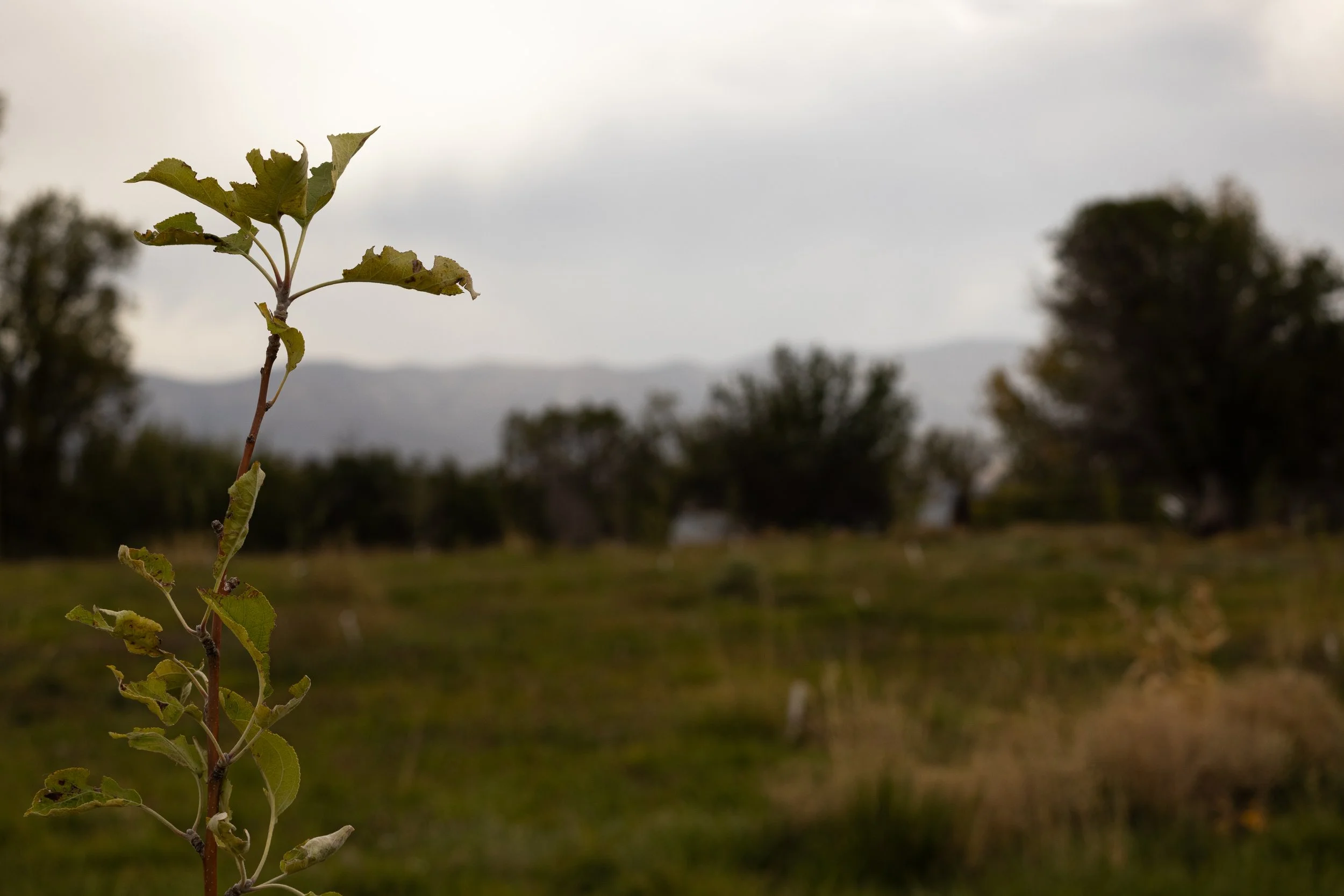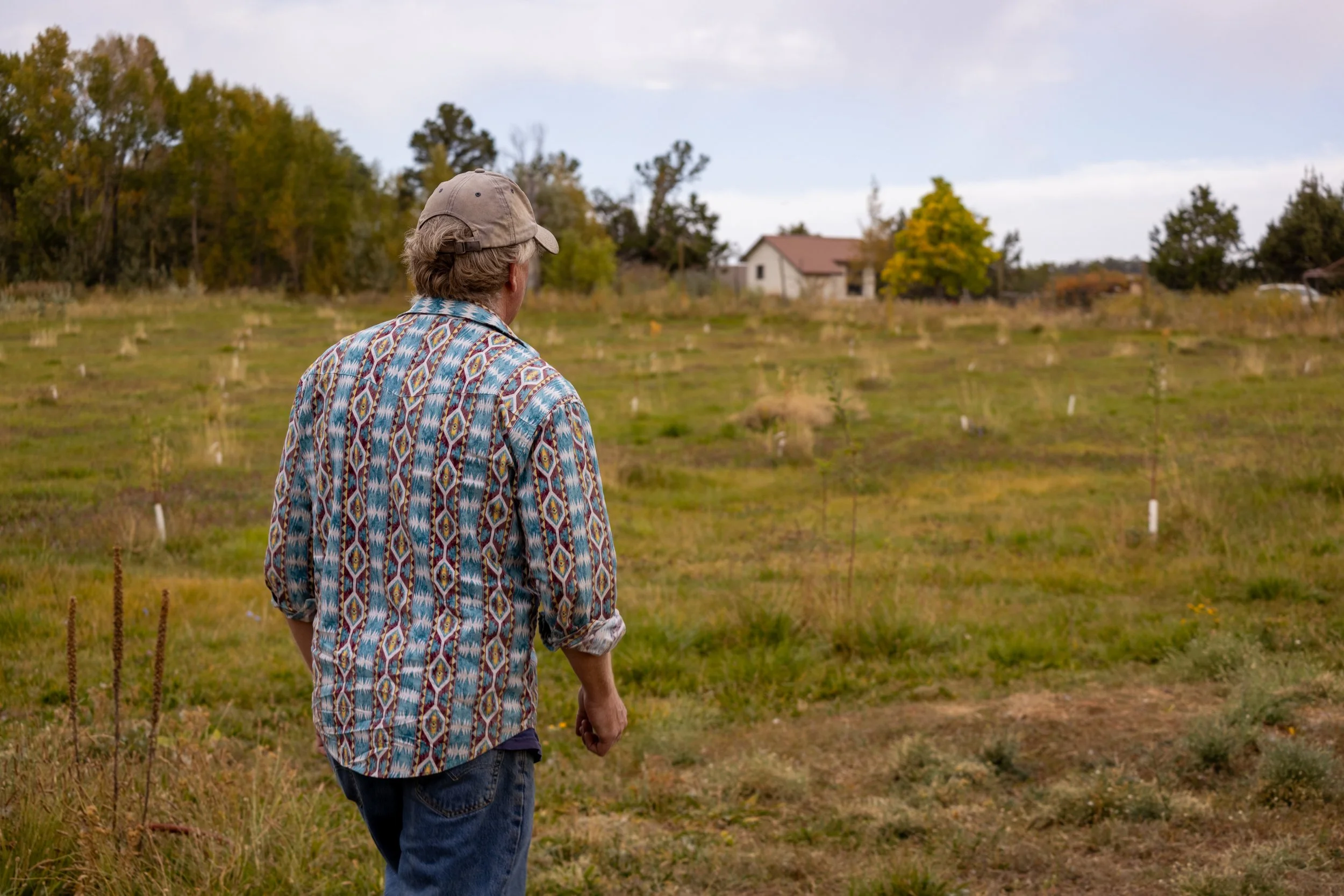Come here, young one, up to Jude Schuenemeyer’s orchard restoration site on the outskirts of Montezuma Valley. Here, you will find me, a winter banana apple tree at the top of the gravel road. I have a broad umbrella shape, full of light green leaves with a few mini yellow ones sprinkled in the mix. They are raindrop-shaped with ruffled edges, and some fold like tacos. Once you find me, sit under these low barren branches where I can protect you from the cold breeze. Then, I can recite the story of us, the apple trees, this land, and its friends.
My brethren, who used to be bountiful and diverse, were lost to time– one by one, being forgotten. I watched as our caregivers walked away, allowing their branches to shrivel, their roots to rot, and their trunks to be chopped for kindling. Leaving me anxious, awaiting my paralysis doom.
We haven’t always lived on these lands, being brought over the expansive ocean blues. This story begins with one that I heard from the soil, who's always listening and remembering every footprint. For years, we lived joyously, in picturesque tall orchards, scattered. Kids would climb up our rigid trunks to shake out the apples. Eventually, wealth grew in America, the aristocrats that you read about in your history books, like … oh, what are their names? Yes, the Washingtons and Jeffersons. They used slave labor to graft their cider orchards with mediocre juicing trees, shifting our apple narrative. Back when George Washington was a general fighting the Six Nations of Iroquois over fertile land, he decided to starve them out— the quickest way to end a battle. So, he sent the soldiers to burn the Six Nations’ homes and food sources. When the soldiers arrived, they found the tribes' beautifully cultivated orchards, anguishing at the thought of destruction. In their eyes, it was too civilized to be created by beings they saw as lower than human. It was a massacre— black ash floating above the blazing red, yellow, and orange. There were many lost that day. These stories, although sad, need to be shared, not left with the soil.
The exploitation of others never ceased to exist, even here in the West, where the history I have seen begins. It all starts with a fellow named Jasper Hall, “the fruit wizard of Montezuma County,” or my creator. He was considered the crazy man in town— wanting to plant an orchard way up here, about 68,000 feet in elevation. On the contrary, there was some truth behind their words; it is rough to grow up here— suffocatingly dry air and the bone-chilling wind— one might say it is miserable, but it is all I have ever known. Nevertheless, we produce some of the “most outrageously high-quality fruit on earth”— I might be slightly biased.
Eventually, Jasper passed away, as we all will someday. Leaving me behind to watch the seasons change, my leaves turning the array of Autumn colors, dropping to the ground, leaving me barren and cold only to be made new with each blossom. It was a lonely century, but I was not completely alone— apple orchards multiplied across the valley— we were everywhere, supporting the local culture. But just as quickly as they arrived, they left— either withered away in the presence of codling moths or forgotten by their keeper.
Oh, coddling moths, I shiver just thinking about them. Their slimy magot-like larve bore wholes into our fruit's flesh and cacoon themselves in our trunks, bringing destruction with each phase of their lives. They ravaged so many trees, taking the orchard community with them. Eventually, you humans came up with a solution to save our kind— DDT. World War II had just ended, and it came out commercially— killing everything in its path.
If you thought coddling moths were bad, you are sorely mistaken that was the least of our problems. Nothing compares to the fight against the industrialization of agriculture, trying to produce more and more for cheaper. We used to be plentiful, we were in everyone's backyards, no tree alike. But then, many small orchards turned into a few huge orchards. For crying out loud, I am a winter banana apple tree, when have you ever seen one of those in your local grocery store? I can almost promise that your response is never— it’s always the honey crisp, red delicious, or the granny smith for your pies.
It was undeniably a gloomy century, but before I knew it, Jude and Addie Schuenemeyer purchased the orchard way up here. With it, about 20 years ago, they started the Montezuma Orchard Restoration Project, also known as MORP, to keep more of my brethern from being forgotten.
They stumbled upon this occupation after learning about Montezuma's crumbling apple orchard culture. At first, it was like watching a toddler learn to walk, waddling around and fumbling quite frequently, but before I knew it, they were running. It just took support from the community and a few copies of Jasper Halls’ articles.
Now, their cultivar preservation project is optimistically improving— documenting 436 varieties of apples planted in Colorado before 1930. I watched with hope, sitting at the edge of my seat as he and his team scoured through historical records like starving animals trying to salvage as much as possible. Although many were found, a good portion of their list has been noted as lost or extinct. And for my brethren who are holding onto their last thread, Jude hunts for their story and works to revive their verity so they are not forgotten to time.
As part of keeping us around, he works to help other orchardists stay afloat. You might not know this, but we produce way more apples than what is ever seen in your local stores— are rejected for their unique Buetty or never even collected. Each apple that is rejected can be detrimental to the small orchards because that was money going in but not out. So, Jude has come up with a solution. He has this fancy smancy juicing machine in the shed across the way. About this time of year, he will roll it out onto that level cement slab, and with a few presses of buttons, the rejected apples are funneled through one silver tube to another. It's kinda crazy to watch I have no clue how it works, I just know it makes a lot of noise, and in one moment, there are apples, and in the next, there is apple juice. The juice allows the orchardists to make back some revenue that they would have lost.
I know that even once Jude is gone, MORP will last, and my brethren and I will be protected. That we apple trees, even the most out there like I, will have a place to be remembered.
You have been listening to what this old apple tree had to say all day; you are probably getting cold by now. So, go on and enjoy your afternoon. But every time you see an apple no matter its size, shape, color, texture, flavor, or the number of bruises, remember me, all my lost brethren, and the complexities behind every bite.



